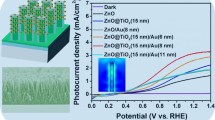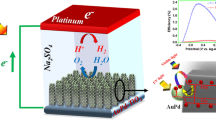Abstract
To improve the separation efficiency of photoinduced charge carries, Au@SiO2 nanoparticles (NPs) with core–shell structure were loaded onto the surface of TiO2 nanorods grown on fluorine-doped tin oxide substrate by a facile two-step process. The resulted Au@SiO2/TiO2 photoanodes were characterized by X-ray diffraction, scanning electron microscopy, transmission electron microscopy, as well as photoelectrochemical measurements. Compared with pristine TiO2 nanorod film, the Au@SiO2/TiO2 films showed remarkable enhancement in photoelectrochemical water splitting, with incident photon-to-current conversion efficiency increasing from 31 % to 37 % at 380 nm at 0.7 V versus saturated calomel electrode. This could be interpreted by the effect of metallic surface plasmon resonance of Au@SiO2 NPs, which would generate an intense electromagnetic field with spatially nonhomogenous distributed intensity. As a result, the charge carriers generated in the near-surface region of TiO2 nanorods could be easily separated. This modification method based on the effect of metallic surface plasmon resonance for promoted charge carrier separation provides a promising way to develop semiconductor photoelectrodes with high solar water-splitting performance.







Similar content being viewed by others

References
Chen X, Shen S, Guo L et al (2010) Semiconductor-based photocatalytic hydrogen generation. Chem Rev 110:6503–6570
Shen S, Shi J, Guo P et al (2011) Visible-light-driven photocatalytic water splitting on nanostructured semiconducting materials. Int J Nanotechnol 8:523–591
Asahi R, Morikawa T, Owaki T et al (2001) Visible-light photocatalysis in nitrogen-doped TiO2. Science 293:269–271
Nakade S, Saito Y, Kubo W et al (2003) Enhancement of electron transport in nano-porous TiO2 electrode by dye absorption. Electrochem Commun 5:804–808
Deng HH, Zhou YM, Mao HF (1998) The mixed effective of phthalocyanine and prophyrin on the photoelectric conversion of a nanostructured TiO2 electrode. Synth Metal 92:269–274
Tsuji I, Kato H, Kobayashi H et al (2004) Photocatalytic H2 evolution reaction from aqueous solutions over band structure-controlled (AgIn) x Zn2(1–x)S2 solid solution photocatalysts with visible-light response and their surface nanostructures. J Am Chem Soc 126:13406
Wu G, Chen T, Zhou G et al (2008) H2 production with low CO selectivity from photocatalytic reforming of glucose on metal/TiO2 catalysts. Sci China Ser B Chem 51:97–100
Shen SH, Mao SS (2012) Nanostructure designs for effective solar-to-hydrogen conversion. Nanophotonic 1:31–50
Brown M, Suteewong T, Kumar RS et al (2011) Plasmonic dye-sensitized solar cells using core-shell metal-insulator nanoparticles. Nano Lett 11:438–445
Zhou X, Hu C, Hu X et al (2010) Plasmon-assisted degradation of toxic pollutants with Ag-AgBr/Al2O3 under visible-light irradiation. J Phys Chem C 114:276–282
Neatu S, Cojocaru B, Parvulescu VI et al (2010) Visible-light C-heteroatom bond cleavage and detox-ifi cation of chemical warfare agents using titania-supported gold nano-particles as photocatalyst. J Mater Chem 20:4050–4054
David BI, Suljo L (2011) Water splitting on composite plasmonic-metal/semiconductor photoelectrodes: evidence for selective plasmon-induced formation of charge carriers near the semiconductor surface. J Am Chem Soc 133:5202–5205
Suljo L, Phillip C, David BI (2011) Plasmonic-metal nanostructures for efficient conversion of solar to chemical energy. Nat Mater 10:911–921
Liu ZW, Hou WB, Pavaskar P et al (2011) Plasmon resonant enhancement of photocatalytic water splitting under visible illumination. Nano Lett 11:1111–1116
Thomann I, Pinaud BA, Chen ZB et al (2011) Plasmon enhanced solar-to-fuel energy conversion. Nano Lett 11:3440–3446
Chen J, Shen SH, Guo PH et al (2013) Plasmonic Ag@SiO2 core/shell structure modified g-C3N4 with enhanced visible light photocatalytic activity. J Mater Res 29:64–70
Liu B, Aydil ES (2009) Growth of oriented single-crystalline rutile TiO2 nanorods on transparent conducting substrates for dye-sensitized solar cells. J Am Chem Soc 131:3985–3990
Bastús NG, Comenge J, Puntes V et al (2011) Kinetically controlled seeded growth synthesis of citrate-stabilized gold nanoparticles of up to 200 nm: size focusing versus Ostwald ripening. Langmuir 27:11098–11105
Liu SH, Han MY (2005) Synthesis, functionalization, and bioconjugation of monodisperse, silica-coated gold nanoparticles: robust bioprobes. Adv Funct Mater 15:961–967
Cushing SK, Li JT, Meng F et al (2012) Photocatalytic activity enhanced by plasmonic resonant energy transfer from metal to semiconductor. J Am Chem Soc 134:15033–15041
Cláudia GS, Raquel J, Tiziana M et al (2011) Influence of excitation wavelength (UV or visible light) on the photocatalytic activity of titania containing gold nanoparticles for the generation of hydrogen or oxygen from water. J Am Chem Soc 133:595–602
Chen JJ, Jeffrey CS, Wu P et al (2001) Plasmonic photocatalyst for H2 evolution in photocatalytic water splitting. J Phys Chem C 115:210–216
Scott CW, Elijah T (2012) Plasmonic solar water splitting. Energy Environ Sci 5:5133–5146
Acknowledgments
This work was supported by the National Natural Science Foundation of China (51102194, 51323011, and 51121092), the Doctoral Program of the Ministry of Education (20110201120040), and the Nano Research Program of Suzhou City (ZXG2013003). S. Shen was supported by the Foundation for the Author of National Excellent Doctoral Dissertation of China (201335), and the Fundamental Research Funds for the Central Universities.
Author information
Authors and Affiliations
Corresponding author
Additional information
SPECIAL ISSUE: Advanced Materials for Clean Energy
About this article
Cite this article
Chen, J., Yu, M., Wang, Y. et al. Au@SiO2 core/shell nanoparticle-decorated TiO2 nanorod arrays for enhanced photoelectrochemical water splitting. Chin. Sci. Bull. 59, 2191–2198 (2014). https://doi.org/10.1007/s11434-014-0188-7
Received:
Accepted:
Published:
Issue Date:
DOI: https://doi.org/10.1007/s11434-014-0188-7



